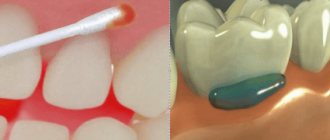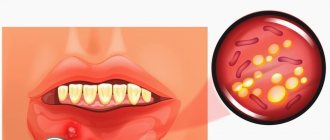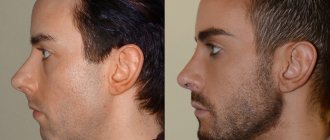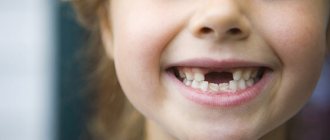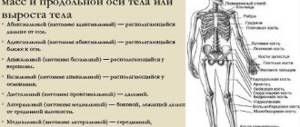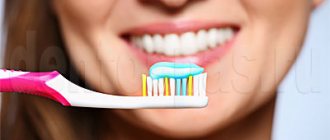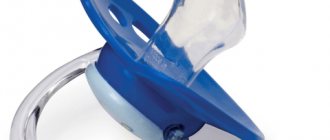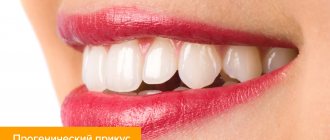- Causes
- Signs of pathology
- Classification of pathology
- What complications can there be?
- Treatment and correction of distal bite
Distal bite is a pathology in which the occlusion (closing) of the upper and lower jaws is disrupted.
In this case, the teeth of the upper jaw protrude much forward relative to the lower jaw. Another name for the anomaly is prognathia. It has a negative effect on appearance, causes consequences in the form of disruption of the digestive system, and psychological problems. If a distal bite is diagnosed, correction is faster and easier in childhood. Correction in adults is also possible, but it requires a lot of effort and time.
Symptoms
With dental occlusion, the following facial features are characteristic:
- large cheeks and cheekbones, the face seems convex;
- the wings of the nostrils look upward;
- because of the small lower jaw, the profile is called “bird-like”;
- since the lower lip is placed under the front teeth, the mouth can often be half-open;
- the upper lip is denser;
- there is a pronounced fold at the chin.
The patient speaks with a lisp or burr; the stronger, the higher the degree of distal occlusion. Posture disorders are characteristic.
For teeth and jaws, symptoms include:
- the dentition is directed from the lower jaw;
- gaps between the front teeth antagonists more than 5 mm;
- there is crowding of teeth, some elements are deployed;
- underdeveloped narrow lower jaw;
- The side teeth may not close completely.
Pathology can occur in combination with an open, deep bite. If a distal open bite is detected, it is necessary to begin treatment immediately to try to avoid surgical intervention.
Violation of facial geometry
A violation of the geometry is observed in cases where the front teeth are pushed forward in relation to the lower teeth. In such patients, the lower jaw is much weaker than the upper jaw and is also small in size.
Patients with impaired facial geometry have a small and sharp chin, so they are often called indecisive and weak, based only on the external image of the person.
Causes of the disease
The causes of distal occlusion can be laid down in intrauterine development. When the skull and maxillofacial joints are formed. Illness of a pregnant woman, taking certain medications and drugs can affect the appearance of pathology, as well as other factors:
- heredity;
- rickets, bone diseases;
- incorrect posture;
- early/late change of primary teeth;
- deviated nasal septum, ENT diseases that make nasal breathing difficult and make it a habit to breathe with an open mouth;
- habit of sucking fingers, chewing pens, etc.;
- injuries, tooth fractures;
- incorrectly selected removable denture or its incorrect use.
Up to 90% of children have a distal bite; the anomaly of the dentition is not always pronounced. In the adult population, this defect occurs in up to 30% of the total.
What factors influence malocclusion? Is there any way to avoid the problem?
Typically, the bite develops in people between infancy and about 17 years of age. It may be incorrect due to the following reasons:
- genetic predisposition;
- bad childhood habits: pacifier sucking, bottle feeding, finger sucking;
- problems with the spine that have not been corrected;
- chronic ENT diseases (for example, adenoiditis);
- calcium deficiency, as a result of which bone tissue is not formed correctly.
It is important! If a child breathes predominantly through his mouth during sleep, play, or in a calm state, this is one of the signals of problems, which may include an incorrect bite. The faster occlusion pathologies are corrected, the less likely it is that not only dental problems will occur, but also ENT diseases.
Classification
There are several types of classification of distal occlusion.
According to the location of the upper dentition relative to the lower:
- I form
of bite. The incisors are fanned out as the jaw arch narrows in the lateral sections. - II form
. The anterior teeth are inclined towards the palate, and the lateral incisors are partially rotated and have a distal slope.
According to morphological characteristics, they are distinguished:
- dentoalveolar form. The defect is expressed due to incorrectly located teeth, the alveolar processes do not correspond to each other. The lower incisors often injure the upper alveolar ridge.
- gnathic form. Abnormal development of the jaws and their location in the skull.
- combined form. A combination of abnormalities of the teeth and jaw.
Another classification of distal occlusion according to Betelman:
- lower micrognathia, but the upper jaw is normal;
- the upper jaw is enlarged, but the lower jaw is normal;
- the upper one is enlarged, the lower one is underdeveloped;
- prognathia of the upper jaw and lateral compression of the dentition.
What is distal occlusion, basic information
A distal bite (also known as prognathic) is an incorrect arrangement of the jaws in the oral cavity, in which the upper jaw protrudes above the lower jaw. The difference in protrusion may depend on individual characteristics and the functional structure of the skull bones .
With this problem, the correct relationship of the dentition is disrupted: the teeth begin to “find” each other, intersect, which causes abrasion of the tooth enamel and subsequent destruction.
Complications
The consequences if deep distal dental bite is not treated can be as follows:
- problems in the gastrointestinal tract due to impaired chewing and swallowing. The entire load goes to the back lateral teeth;
- increased abrasion of teeth, as a result of which caries easily occurs; if left untreated, it can develop into root granuloma and cause tooth loss;
- ugly facial features, “bird profile”;
- periodontal inflammation, injury to gum tissue and palate by cutting edges of teeth;
- violation of diction;
- discomfort, pain in the temporomandibular joint.
Complications may also arise during implantation and prosthetics.
How can you determine whether your bite is correct or not?
You can evaluate your bite by simply performing a simple test. Stand in front of a mirror and close your jaws to form a central occlusion. Smile widely and see if there is a gap between the upper and lower jaws? If the rows are in close contact with each other, there are no obvious gaps, there is a high probability of correct teeth bite.
The dentist will do this professionally:
- will perform a visual examination - as a rule, a professional doctor will see obvious pathologies of the jaw bite from the first seconds;
- recommends making an orthopantomogram, which will also help visualize possible pathologies of the upper and lower jaws, teeth and bite in general.
Methods and stages of treatment
Treatment for children and adults is different. The jaw bones grow at an early age, and it is easier to put them and teeth in place, since correcting a distal bite with established tissues is more difficult.
Methods for correcting distal occlusion in children
You can start therapy from 3 years of age. This will include myogymnastics, alveolar massage, and later the use of orthodontic appliances. They will help stimulate the growth of the lower jaw and slow down the upper jaw. These include the Frenkel regulator, Rogers and Dass activators, models complete with screws, etc.
Trainers
— elastic mouthguards train muscles, relaxing the tone of overly tense muscles.
They are worn at night and used for a couple of hours a day. It may take 4-12 months
.
Orthodontic plastic surgery
with a metal arc acts on the teeth with a certain force.
The result will be in 6-18 months
.
Correction of distal bite with braces
may be prescribed as early as adolescence.
The bracket system is a non-removable structure (external metal, lingual, ceramic). A bracket is fixed to each tooth and a metal arch is threaded through it, forcing it to return to the correct position by applying pressure to the pathological area. Within several years of use ( 1-2 years
), the system will be able to straighten teeth and change the bite.
Treatment of distal occlusion in an adult
If the pathology is not too severe, braces, splints, a chin guard and an elastic band are sufficient. of 1.5 to 3 years to correct a distal bite with braces
.
Surgical treatment of occlusion may only include the removal of several teeth; in case of a deep distal bite, an operation (osteotomy) will be performed to dissect the jaw tissue and install a corrective structure. Its task is to stretch and lengthen the lower jaw with the correct location in the TMJ area. Afterwards, you will need to wear braces or other devices for a designated period of time.
Why does distal overbite occur?
It is customary to divide anomalies of the dentofacial system into separate categories. Among them:
- Hereditary factor.
- A bite inherited from childhood.
- Development of malocclusion during intrauterine life.
The information concerns all anomalies of the dental system without exception. When it comes to the causes of distal bite, they usually include the following:
- chronic disease of the mouth and nose;
- children have bad habits;
- poor posture;
- premature tooth loss.
Now we will take a closer look at the factors that can leave a serious imprint on the formation of a distal bite in a person.
Hereditary factor
Today, the manifestation of a hereditary factor in the formation of numerous dental anomalies causes controversy among doctors who cannot come to a consensus. Approximately half of the specialists are confident that it is the hereditary factor that largely influences the formation of the distal bite.
Why was this conclusion made? Twin children in different families were studied, after which a direct dependence of the hereditary factor on the formation of distal occlusion in individual children was established . It was possible to identify the dominant factor of heredity.
Of the 576 cases of malocclusion in twins studied, distal malocclusion was observed in only 85% of cases. It can also be assumed that a hereditary factor is a predisposition to the development of malocclusions. They can develop only in conditions of human life and development that are favorable for this.
External factors influence the appearance and healing of distal bite, which is important to remember for everyone who wants to get rid of this problem. If you think that you have a predisposition, it is recommended to carry out diagnostic medical measures in advance, as well as select a possible treatment option.
Chronic diseases of the nose and mouth
Chronic colds can affect the formation of incorrect, distal occlusion. The main feature of such diseases is the obstruction of the airways. A child, and some adults, have to breathe through their mouth due to a stuffy nose.
Mouth breathing creates a high palate and leads to a narrowing of the upper jaw.
Bad habits in children
Oddly enough, it is your child’s bad habits that can lead to the formation of a distal bite. They lead to a change in the inclination of the teeth and a shift in the position of the jaw in the oral cavity.
If you do not wean your child off habits in time, they can result in a change in the shape of the face and the development of a distal bite, which will be much more expensive and time consuming to treat and correct. The main habit inherent in children is thumb sucking. This could be a trigger!
In children, the causes of malocclusion can be:
- improper swallowing of food;
- violation of chewing function;
- mouth breathing;
- incorrect pronunciation of sounds;
- tongue pressure on teeth.
Many children have not one, but several bad habits at the same time, which only aggravates the situation and requires an immediate reaction from parents.
If you notice that your baby doesn’t let his finger out of his mouth, breathes through his mouth, or presses his tongue on his teeth, try to wean him off this.
There are special techniques that allow you to wean children from bad habits, which greatly simplifies their task for parents.
Poor posture
Poor posture is another specific cause that can lead to improper positioning of the jaws in the mouth.
Correct body posture means keeping the baby's back and head at the same level. Once misalignment and poor posture occur, there is a predisposition to the development of a distal malocclusion.
An important piece of advice for parents is to be sure to monitor your child's posture.
Losing baby teeth earlier than expected
Early loss or removal of primary teeth is also considered to be a contributing factor to the occurrence of jaw abnormalities. Unfortunately, in most cases there are clear recommendations and instructions from a doctor for removal, so there is no escape from this.
What happens to the jaw if baby teeth fall out early? Permanent molar teeth, due to an excess of free space on the gum, can grow with an incorrect angle of inclination or location on the gum.
Forecasts, timing
The prognosis for treatment of distal occlusion is favorable. Before 95%
patients solve this problem with an orthodontist. And the earlier the correction begins, the faster and easier it will be. For children it may take six months to a year, and for adults it may take several years.
The photo shows an example of distal bite correction at the ROOTT clinic
Treatment of distal occlusion in adults
Since in adults, correcting the bite is quite difficult and sometimes causes pain, it is proposed to use special braces that perfectly cope with their main task.
If the stage of distal occlusion is advanced, in addition to brace systems, auxiliary devices are installed and even surgical intervention is performed. The main disadvantage of this approach is the feeling of pain and the long period of rehabilitation for patients.
Clients are offered the following methods to choose from:
- hardware-surgical complex;
- surgical intervention;
- combination method;
- prosthetic method.
The correct choice of treatment method is a guarantee of health. Any method is prescribed only after a qualified examination of the patient by a doctor and study of his body characteristics and health in general. The patient's age also plays an important role.
Prevention
Prevention of distal malocclusion should begin at an early age. Main events:
- examination and treatment of respiratory organs;
- natural milk feeding;
- stopping bad habits;
- monitoring correct posture;
- using a pacifier only for a short period of time;
- prevention of rickets;
- timely introduction of solid foods into the child’s diet.
If the specialist considers it necessary, then surgical intervention is performed.
Conclusion
Malocclusion is not only an aesthetic, but also a physiological problem of the dental apparatus. Ignoring the distal anomaly can worsen the quality of life and even cause some diseases, including the digestive tract due to improper chewing of food.
People with distal occlusion suffer from diction problems. Their TMJ function is disrupted. In addition, dental treatment in such patients is also more difficult, and the teeth are more susceptible to carious lesions.
Therefore, if you suspect distal occlusion, you should immediately go to the doctor. A child can be taken for an appointment immediately after the appearance of baby teeth, that is, from about 3 years old.
Posted by:
Final correction of the bite after removal of the Herbst appliance
After removing the Herbst appliance, the orthodontist usually prescribes wearing orthodontic elastics to achieve more correct and dense interdental contacts.
The myofunctional therapist selects a set of exercises aimed at strengthening the correct functioning of the masticatory muscles and maintaining the lower jaw in a new position.
Commentary by myofunctional therapist T.B. Zukor: “When I prescribe exercises to adult patients, I often hear that there is not enough time to complete them. But the stability of a corrected bite depends on proper muscle function! Nobody wants their teeth to become crooked again, and their jaw to go back, because so much effort has been spent. The exercises are not complicated and do not require special sportswear, location or preparation. Do exercises while driving, standing in a traffic jam, when taking a shower, watching TV - any 5-10 minutes will make a significant contribution to your health!”
Throughout the entire orthodontic treatment, the osteopath relieves excess tension in the muscles and joints and helps to quickly adapt to the new bite.
Braces. Bite correction
To correct bites, dentists use the following systems:
- removable structures (mouth guards, plates, etc.);
- non-removable – vestibular braces (metal braces, sapphire braces and ceramic braces) and lingual braces.
Bite correction (orthodontics) is not a painful procedure, but it requires patience and time, and then in due time you will certainly get an excellent result. Nowadays, having a beautiful smile is no longer a luxury, but an affordable pleasure. Agree, having healthy teeth is important, but their aesthetic appearance is no less important. A beautiful smile immediately puts its owner at ease and makes him a charming and pleasant conversationalist. Of course, to correct uneven teeth you will need patience and some time, but it is worth it. Today, even adults get braces because they want to have straight teeth and it’s never too late to make this dream come true. We can offer installation of various types of braces:
- classic braces;
- transparent aesthetic sapphire braces;
- lingual braces (installed on the lingual side);
- ceramic braces.
The lingual brace system is completely invisible, as it is located on the surface of the teeth that faces the tongue, where its clasps are attached. When correcting a bite, one of the main difficulties of working with lingual braces is that, unlike vestibular braces, they are very difficult to place immediately on the teeth in order to begin treatment to correct the shape of the teeth. Therefore, first, braces are attached in a dental laboratory to plaster models of your teeth, and only then, in their final form, are they moved to your teeth. This type of braces requires special education from an orthodontist and a fundamentally different set of tools to install. The entire installation procedure lasts 2-3 hours. This, among other things, explains the considerable difference in price compared to vestibular braces. Lingual braces also have their disadvantages. For example, they are less convenient than their counterparts to use - when eating, talking and brushing your teeth. It usually takes 3-4 weeks to get used to orthodontic equipment. There are also contraindications for installing the system - small dental crowns and multiple missing teeth, as well as the individual characteristics of the patient’s body (according to the indications of the orthodontist). Sapphire braces are very popular due to their transparency and invisibility on the teeth. True, they usually cost more than standard braces, but the result is much more beautiful. Our specialists will install braces for you in compliance with all the necessary rules and so that the result is achieved within the required time frame. We are waiting for you in our clinic for an orthodontic consultation and installation of braces that will change your appearance and give you a beautiful smile.
The cost of correcting the position of teeth is from 15,000 rubles.
You can receive detailed information about the cost of treatment after consulting a dentist.
